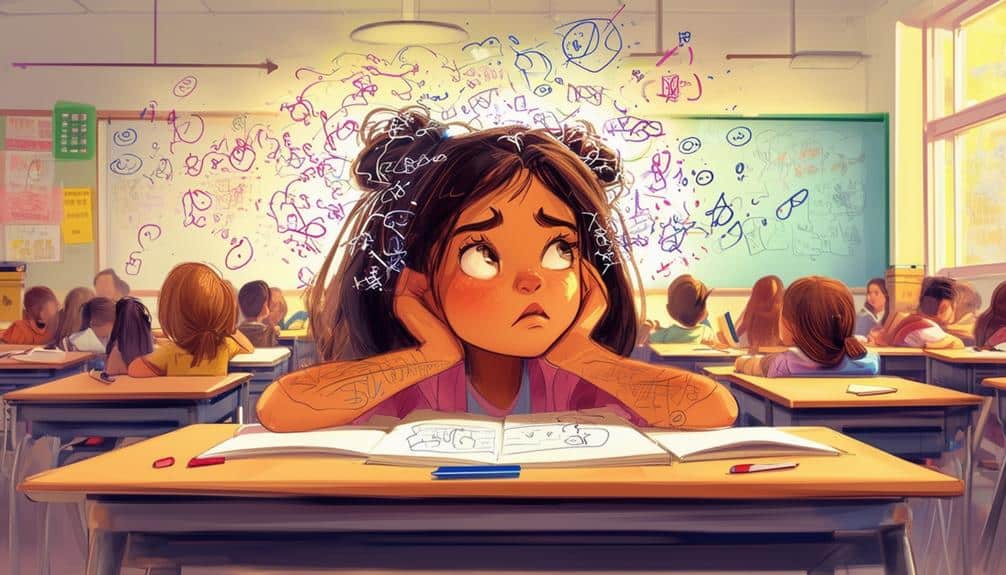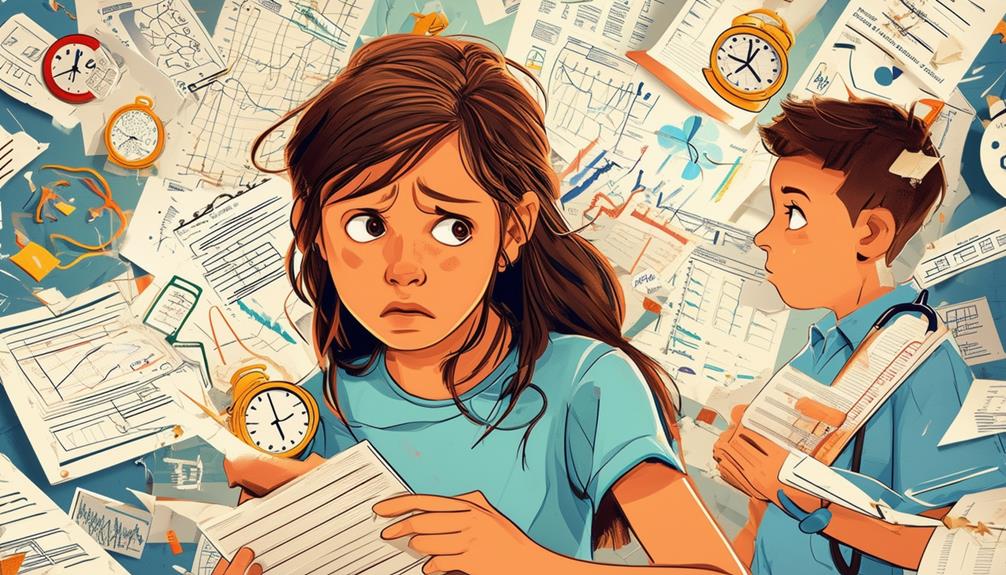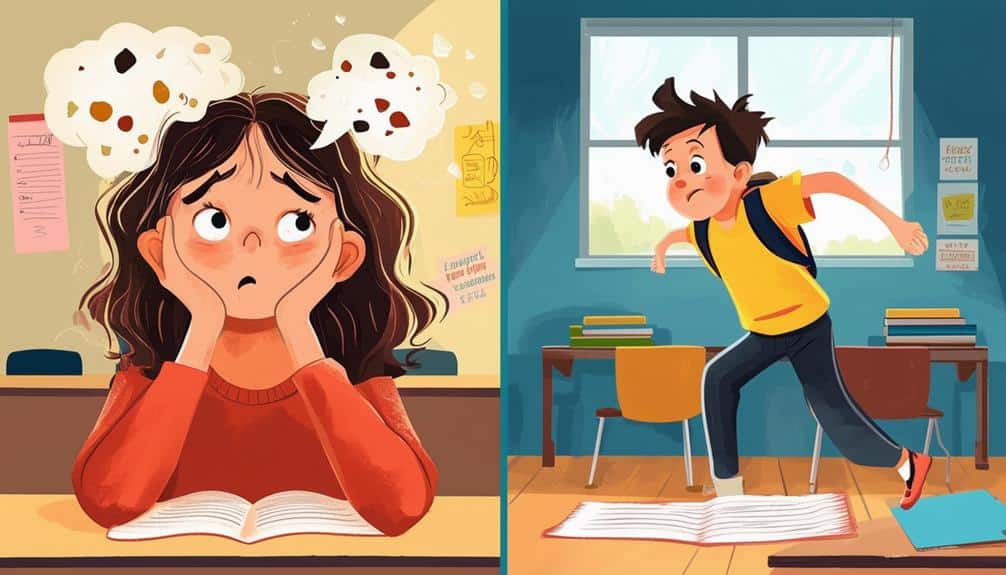ADHD in girls frequently exhibits a unique symptomatology compared to boys. Girls often present with inattentive behaviors and emotional dysregulation, contrasting with the more externalizing and hyperactive behaviors common in boys. This disparity contributes to a higher rate of underdiagnosis in girls, as their symptoms are less overt and can be mistaken for anxiety or depression. Early and accurate identification of ADHD in girls is essential for effective management and support. For detailed insights into recognizing and addressing ADHD in girls, further information is available.
Key Takeaways
- ADHD in girls often presents with inattentive behaviors, contrasting the hyperactive behaviors commonly seen in boys.
- Emotional dysregulation and internalizing symptoms, like anxiety and depression, are more prevalent in girls.
- Girls with ADHD are frequently underdiagnosed, with up to 75% going undetected, leading to delayed or missed treatment.
- Boys typically show externalizing behaviors, while girls internalize, making their symptoms less visible and more challenging to diagnose.
- Girls with ADHD face unique challenges in social interactions, organization, and time management, impacting academic performance and self-esteem.
Understanding ADHD in Girls
Understanding ADHD in girls requires recognizing that their symptoms often present differently than in boys, with a higher prevalence of inattentive behaviors and mood dysregulation. Girls with ADHD frequently exhibit difficulty focusing, organizing tasks, and sustaining attention, which can lead to significant academic challenges. Emotional dysregulation is another distinguishing feature, manifesting as heightened anxiety, low self-esteem, and mood swings. These distinct symptoms often result in girls struggling silently, increasing the risk for depression, anxiety disorders, and eating disorders.
The underdiagnosis of ADHD in girls is a significant concern. Because their symptoms are less disruptive and internalized than boys, girls are less likely to be recognized as needing clinical assessment. This underdiagnosis delays critical intervention, exacerbating academic and social difficulties. Early identification and targeted intervention are essential to mitigating these long-term challenges.
Effective intervention strategies should encompass both behavioral and academic support. Educators and clinicians must be trained to recognize the specific presentation of ADHD in girls. By doing so, they can provide the necessary resources to foster a supportive environment that addresses inattentive symptoms and emotional dysregulation, ultimately promoting better academic and social outcomes.
Common Symptoms in Boys

Boys with ADHD mostly exhibit impetuous and overactive behaviors, which manifest as constant movement, difficulty waiting their turn, and frequent interruptions. These ADHD symptoms are often characterized by hyperactive and reckless behaviors, leading to externalizing behaviors in various settings. Boys with ADHD frequently display physical aggression, excessive talking, and an inability to sit still or stay focused for extended periods. This hyperactivity and restlessness often result in challenges in academic settings, where they may struggle to follow instructions, complete tasks, and adhere to classroom rules.
In social settings, boys with ADHD experience difficulties maintaining self-control, which can lead to reckless decision-making and frequent outbursts of frustration or anger. These behaviors can disrupt peer relationships and impede the development of social skills. Boys may also engage in risky activities due to impulsivity, further exacerbating their challenges.
The externalizing behaviors often observed in boys with ADHD, such as acting out and being disruptive, make it harder for them to integrate seamlessly into structured environments. Addressing these ADHD symptoms requires an all-encompassing approach that includes behavioral interventions and support systems aimed at improving self-control and facilitating positive outcomes in both academic and social domains.
Common Symptoms in Girls

Girls with ADHD commonly exhibit inattentive symptoms such as daydreaming, difficulty focusing, and organizational challenges, which can significantly impact their academic and social functioning. These symptoms in girls often manifest as struggles with time management and emotional regulation, leading to inconsistent academic performance and strained peer relationships. Unlike boys, who more frequently display hyperactive behaviors, girls with ADHD tend to internalize their symptoms. This internalization can precipitate higher rates of anxiety and depression, further complicating the diagnostic process.
Emotional regulation is a significant challenge for girls with ADHD. They may experience intense emotional responses, contributing to low self-esteem and increased verbal aggression. Recognizing these subtle signs is essential, as they are often mistaken for other issues, resulting in delayed diagnosis and intervention. Early intervention is critical to support girls in managing their symptoms effectively and mitigating long-term emotional and academic difficulties.
Additionally, internalized symptoms in girls with ADHD can lead to comorbid conditions such as eating disorders. Therefore, caregivers and educators must be vigilant in identifying these patterns early. Tailored support and intervention strategies can help address the distinct challenges faced by girls with ADHD, promoting better outcomes in their academic and social lives.
Behavioral Differences

Behavioral differences between boys and girls with ADHD greatly influence diagnostic accuracy, treatment approaches, and long-term outcomes. Research highlights apparent gender differences in symptom presentation. Boys with ADHD mainly exhibit hyperactive behaviors and externalizing behaviors, including physical aggression and impulsivity, making their condition more noticeable. Conversely, girls often display inattentive symptoms, such as difficulty focusing and staying organized. These symptoms are less disruptive and may be misinterpreted as daydreaming or passivity.
Girls with ADHD are more prone to internalizing symptoms, such as anxiety and low self-esteem, which can remain unnoticed in typical classroom settings. This internalization contributes to the underdiagnosis and delayed treatment of ADHD in girls, as their less overt behaviors, do not typically trigger immediate concern from educators or caregivers. Consequently, the ratio of ADHD diagnosis skews towards boys, with boys being diagnosed 2-3 times more often than girls.
Understanding these behavioral differences is crucial for clinicians and educators to ensure accurate recognition and timely intervention. Tailored support strategies must address both the inattentive and internalizing symptoms in girls and the hyperactive and externalizing behaviors in boys. A nuanced approach guarantees equitable treatment and better long-term outcomes for all children with ADHD.
Challenges in Diagnosis

The distinctive behavioral presentations of ADHD in boys and girls create significant challenges in achieving accurate diagnoses, especially for girls. Girls with ADHD are often underdiagnosed, mainly because their symptoms can be subtle and easily overlooked. Unlike boys, who typically exhibit more overt hyperactivity and impulsivity, girls usually display inattentiveness or are mislabeled as being simply immature or emotionally sensitive.
This diagnostic disparity is concerning, as research indicates that up to 75% of girls with attention issues may go undiagnosed. Several factors contribute to this underdiagnosis:
- Subtle Presentation: Girls with ADHD may exhibit less disruptive behaviors, making their condition less noticeable to teachers and parents.
- Misinterpretation of Symptoms: Symptoms in girls can be mistaken for other issues such as anxiety, depression, or even typical developmental phases.
- Lack of Awareness: There is a general lack of awareness about the distinct signs of ADHD in girls among healthcare providers and educators.
Understanding these challenges is essential for timely intervention. Recognizing the distinct signs of ADHD in girls can lead to more accurate diagnoses, better support systems, and tailored interventions that address their specific needs. Early and precise diagnosis is essential to mitigate long-term academic and social challenges.
Impact on Daily Life

The daily lives of girls with ADHD are often significantly impacted by challenges in academic performance and social interactions. Struggles with organization, time management, and mood regulation can lead to difficulty maintaining academic standards and forming healthy peer relationships. These challenges can further exacerbate issues related to self-esteem and psychological well-being, necessitating targeted interventions to support their holistic development.
Academic Performance Challenges
Females with ADHD often face substantial academic performance challenges because of inherent difficulties with attentiveness, organization, and task completion. These factors contribute significantly to lower grades, incomplete assignments, and overall academic underachievement. Girls with ADHD frequently exhibit inattentiveness and disorganization, which impairs their ability to manage time effectively and stay on task. Consequently, these students often struggle to meet academic requirements, leading to a cycle of frustration and diminished self-esteem.
The academic challenges faced by girls with ADHD can manifest in various ways:
- Lower Grades: Persistent inattentiveness and disorganization often result in lower academic performance, as these students struggle to keep up with their peers.
- Incomplete Assignments: Difficulty focusing and managing time effectively leads to many unfinished or poorly executed assignments.
- Time Management Issues: Girls with ADHD frequently have trouble adhering to deadlines and organizing their study schedules, further exacerbating their academic struggles.
These academic difficulties impact the girls’ immediate educational outcomes, self-esteem, and motivation. Educators and caregivers must recognize these challenges and implement supportive strategies to help girls with ADHD navigate their academic environments more successfully. Tailored interventions can foster improved academic performance and enhance overall well-being.
Social Interaction Difficulties
In addition to academic performance challenges, girls with ADHD frequently encounter significant difficulties in social interactions, which profoundly affect their daily lives. These social challenges often manifest as trouble forming and maintaining relationships, leading to pervasive feelings of isolation and rejection. The inability to understand social cues and effectively manage emotions further complicates their interactions, intensifying their struggles to make and keep friends.
The impact of these social difficulties extends beyond peer interactions, influencing school performance and overall mental well-being. Girls with ADHD may experience low self-esteem and increased vulnerability to mental health issues such as anxiety and depression. The persistent social challenges they face contribute to feelings of isolation, exacerbating their emotional distress and hindering their emotional development.
Addressing these social interaction difficulties is essential for the overall development and mental health of girls with ADHD. Interventions focused on enhancing social skills, emotional regulation, and self-esteem can significantly improve their ability to form and maintain relationships. By providing targeted support, caregivers and educators can help mitigate the adverse effects of ADHD on social interactions, promoting better mental well-being and a more inclusive social environment for these girls.
Strategies for Support

To effectively support girls with ADHD, implementing individualized learning plans can accommodate their specific cognitive and attentional needs. Moreover, teaching emotional regulation techniques is vital for managing internalizing behaviors and mitigating risks of anxiety and depression. These tailored strategies foster both academic success and emotional well-being, addressing the distinct challenges faced by girls with ADHD.
Personalized Learning Plans
Tailored learning plans are vital for addressing the specific symptomatology of ADHD in girls, mainly focusing on inattention, organizational skills, and emotional regulation. Girls with ADHD often exhibit different symptom presentations that require customized learning plans to manage academic challenges effectively. These tailored support strategies aim to alleviate difficulties related to focus, time management, and self-esteem, which are more prominent in girls.
Key components of effective personalized learning plans include:
- Extended Time and Structured Routines: Accommodations such as extended time for assignments and structured routines help girls with ADHD manage their workload efficiently.
- Goal-Setting Strategies: Incorporating clear, achievable goal-setting strategies fosters a sense of accomplishment and helps maintain focus on academic tasks.
- Collaboration: Collaboration between educators, parents, and mental health professionals is essential for creating and implementing these tailored interventions.
Such plans address academic challenges and support emotional regulation and overall well-being. Integrating study skills training and mindfulness techniques can enhance these customized learning plans. By prioritizing a collaborative approach, stakeholders can ensure that the specific needs of girls with ADHD are met, promoting their academic success and emotional development.
Emotional Regulation Techniques
Practical techniques for regulating emotions are essential for supporting girls with ADHD in managing their symptoms and improving their overall well-being. Emotion regulation techniques such as deep breathing and mindfulness can play a pivotal role in helping these girls maintain focus and reduce anxiety. Deep breathing exercises, for instance, can be easily integrated into daily routines, providing immediate relief in stressful situations.
Mindfulness practices, which emphasize present-moment awareness, have been shown to enhance emotional stability and reduce impulsivity in girls with ADHD. Journaling is another potent tool, offering a structured way for girls to express their feelings and reflect on their experiences, fostering emotional insight and control.
Additionally, teaching coping strategies such as positive self-talk can empower girls with ADHD to counteract negative thought patterns and build resilience. Cognitive-behavioral therapy (CBT) is also a highly effective approach, equipping these girls with skills to identify and modify dysfunctional emotions and behaviors.
Encouraging physical activity and creative outlets further aids in emotion regulation, providing constructive avenues for managing stress. Lastly, a supportive environment and consistent routines are essential in helping girls with ADHD develop and maintain healthy emotion regulation habits.
Frequently Asked Questions
How Is ADHD in Girls Different From Boys?
ADHD in girls often manifests as inattentiveness and internalizing behaviors, such as anxiety and low self-esteem. In contrast, boys typically exhibit hyperactivity and externalizing behaviors like aggression—this contrast results in underdiagnosis and delayed treatment in girls.
How Does ADHD Show Up in Girls?
Girls with ADHD often exhibit symptoms like a tangled web of inattention, including frequent daydreaming, organizational struggles, and emotional dysregulation. These manifestations can lead to significant academic challenges, anxiety, and potential misdiagnoses, demanding nuanced clinical attention.
What Does ADHD Look Like in Boys?
In boys, ADHD often manifests through hyperactive and impulsive behaviors, including constant movement, difficulty staying seated, interrupting others, acting without considering consequences, and struggling to follow instructions, wait their turn, and control physical aggression.
Is ADHD Diagnosed More Often in Girls Than in Boys?
ADHD is diagnosed more frequently in boys than in girls, with a ratio of approximately 2-3:1. This disparity may be attributed to gender differences in symptom presentation, necessitating heightened awareness for accurate identification and intervention in girls.
Conclusion
ADHD in girls often looks different than in boys, raising questions about how we diagnose this disorder. Clinicians and pediatric occupational therapists need to recognize gender differences in ADHD symptoms to ensure girls get accurate and timely diagnoses. This means being aware of symptoms of inattention and impulsive behaviors that might be overlooked in girls.
To address this challenge, we need to focus on gender-specific symptoms and develop support systems that work for girls. Previous studies show that girls with ADHD may face different levels of impairment, especially in social and academic areas. By refining diagnostic criteria, pediatric occupational therapists can better support girls and reduce the negative impact of ADHD on their lives.
Finally, improving our understanding of ADHD in girls can help us create better intervention strategies. With tailored support from pediatric occupational therapy, girls with ADHD can achieve better outcomes in school and their personal lives. It’s crucial to enhance our awareness and adapt our methods to meet the unique needs of girls with this neurodevelopmental disorder.


Recent Comments